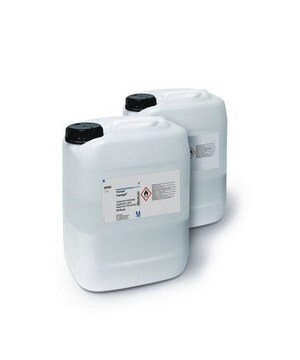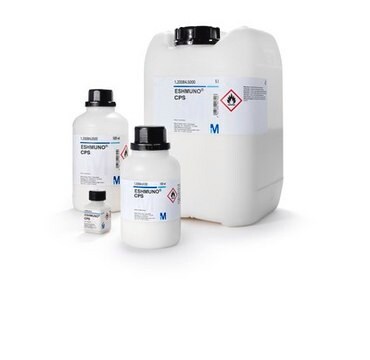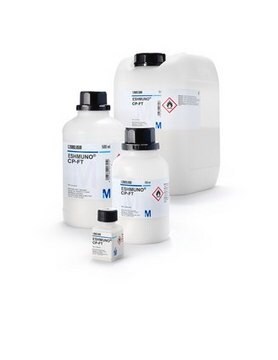1.16890
Fractogel® EMD SO3⁻ (S) Resin
Sinónimos:
Fractogel® EMD SO₃⁻ (S)
About This Item
Productos recomendados
ligand
(Sulfoisobutyl)
Nivel de calidad
100
400
descripción
strong cation exchanger, suspension in 20% ethanol and 150 mM NaCl (20-40 µm)
esterilidad
sterile (Caustic Stable)
Ensayo
≥90% (HPLC)
Formulario
resin
fabricante / nombre comercial
Calbiochem®
Parámetros
8 bar max. pressure
80 cm/hr flow rate
grupo activo de la matriz
methacrylate
tamaño medio de partícula
20-40 um μm
capacidad
150 mg binding capacity (lysozyme/ml of resin)
temperatura de transición
flash point 35 °C (Does not sustain combustion.)
densidad
1.43 g/cm3 at 20 °C
densidad aparente
1000 kg/m3
técnica de separación
strong cation exchange
Condiciones de envío
ambient
temp. de almacenamiento
2-8°C
¿Está buscando productos similares? Visita Guía de comparación de productos
Envase
- 1.16882.0100: Fractogel® EMD SO3- (S) Resin 100ml
- 1.16882.0010: Fractogel® EMD SO3- (S) Resin 10ml
- 1.16882.0500: Fractogel® EMD SO3- (S) Resin 500ml
- 1.16882.5000: Fractogel® EMD SO3- (S) Resin 5L
Advertencia
Nota de análisis
Microscopic evaluation: Uniform spherical particles,no agglomerates,no fines
Extractable matter (water): ≤ 0.05 %
Cerium: ≤ 10 µg/g
Pressure drop(column: ID=1.6 cm, L=10 cm at 5 ml/min): ≤ 5.0 bar
Particle size (d10): 20 - 28 µm
Particle size (d50): 24 - 34 µm
Particle size (d90): 28 - 38 µm
Colony forming units (TAMC + TYMC): ≤ 100 CFU/ml
Endotoxins: ≤ 1.00 EU/ml
Protein binding capacity (lysozyme): 120 - 180 mg/ml
Functional test (c:d): ≤ 0.15
Functional test (b:a): ≤ 0.15
Functional test: Separation chymotrypsinogen A, cytochrom C and lysozyme
Información legal
Palabra de señalización
Warning
Frases de peligro
Consejos de prudencia
Clasificaciones de peligro
Flam. Liq. 3
Código de clase de almacenamiento
3 - Flammable liquids
Clase de riesgo para el agua (WGK)
WGK 1
Punto de inflamabilidad (°F)
95.0 °F
Punto de inflamabilidad (°C)
35 °C
Certificados de análisis (COA)
Busque Certificados de análisis (COA) introduciendo el número de lote del producto. Los números de lote se encuentran en la etiqueta del producto después de las palabras «Lot» o «Batch»
¿Ya tiene este producto?
Encuentre la documentación para los productos que ha comprado recientemente en la Biblioteca de documentos.
Nuestro equipo de científicos tiene experiencia en todas las áreas de investigación: Ciencias de la vida, Ciencia de los materiales, Síntesis química, Cromatografía, Analítica y muchas otras.
Póngase en contacto con el Servicio técnico



